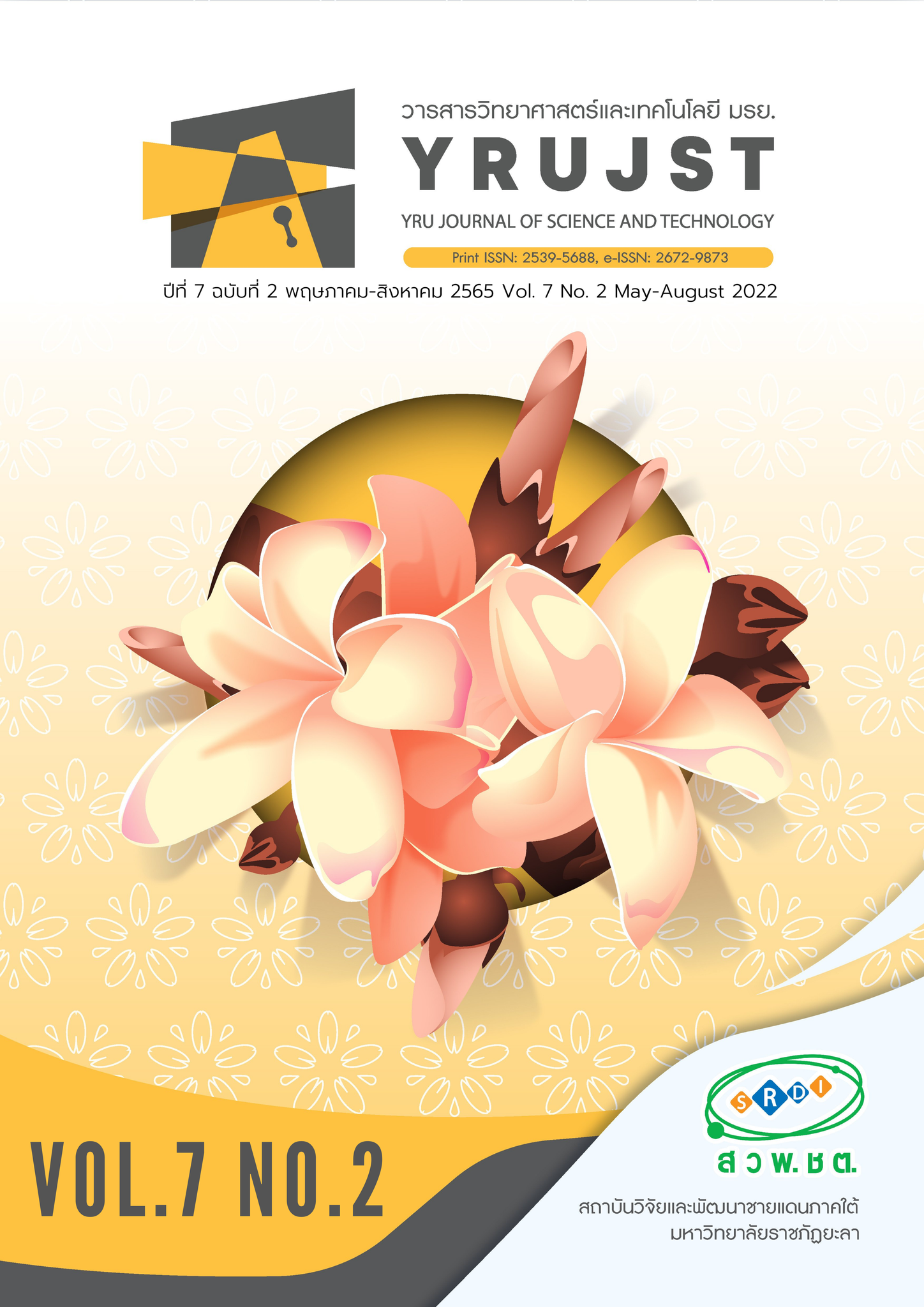การศึกษาประสิทธิภาพและความเป็นไปได้ของการผลิตก๊าซชีวภาพจากน้ำทิ้งจากระบบบำบัด แบบไร้อากาศร่วมกับของเสียกลีเซอรอล
Main Article Content
บทคัดย่อ
ปัจจุบันน้ำเสียจากโรงงานสกัดน้ำมันปาล์ม (POME) เป็นแหล่งผลิตก๊าซชีวภาพที่สำคัญของไทยแต่ POME มีปริมาณผันผวนมากตามฤดูกาล บางช่วงมีปริมาณน้อยและไม่สม่ำเสมอ ไม่เพียงพอต่อความต้องการ ดังนั้นโรงงานจึงต้องพยายามหาวัตถุดิบอื่นมาหมักร่วมเพื่อรักษาอัตราการผลิตให้เพียงพอต่อการใช้งานตลอดทั้งปี งานวิจัยนี้ จึงมุ่งเน้นที่จะศึกษาประสิทธิภาพและความเป็นไปได้ของการนำน้ำทิ้งจากระบบบำบัดแบบไร้อากาศ (ADE) ซึ่งมีค่า COD ถึง 20,000 มิลลิลิตร/กรัม กลับเข้าสู่กระบวนการผลิตก๊าซชีวภาพอีกครั้ง (อัตราส่วน POME/ADE 0-1.0) โดยนำมาหมักร่วมกับของเสียกลีเซอรอล (ร้อยละ 1, 3, 5 และ 7) พบว่า ที่อัตราส่วนของน้ำทิ้งจากระบบบำบัดแบบไร้อากาศร่วมกับน้ำเสียจากกระบวนการสกัดน้ำมันปาล์มที่ 80:20 และเติมของเสียกลีเซอรอลร้อยละ 3 ให้ความเข้มข้นของก๊าซมีเทนสูงที่สุด คือ ร้อยละ 62.09 ให้ผลได้มีเทน 271 มิลลิลิตรมีเทน/กรัมซีโอดี และมีค่า CODremoval ร้อยละ 80 จึงได้นำอัตราส่วนดังกล่าวเข้าสู่การศึกษาด้วยถังปฏิกรณ์แบบกวนผสมต่อเนื่อง (CSTR) ขนาด 10 ลิตร ที่ระยะเวลากักเก็บ 25 วัน ให้ปริมาณมีเทนรายวัน 8,031 มิลลิลิตรมีเทน/วัน และปริมาณมีเทนสะสมภายในระยะเวลา 25 วัน 145,554 มิลลิลิตรมีเทนและคิดเป็นผลได้มีเทนรายวันเฉลี่ย 518 มิลลิลิตรมีเทน/กรัมวีเอส หรือ 299 มิลลิลิตรมีเทน/กรัมซีโอดี และยังพบว่าที่สภาวะดังกล่าวระบบมีเสถียรภาพสูง ให้อัตราการผลิตก๊าซชีวภาพที่สม่ำเสมอ สามารถปรับอัตราการผลิตให้เป็นไปตามความต้องการของโรงงาน ได้ง่าย นำไปใช้จริงในระดับอุตสาหกรรมโดยใช้ระบบเดิมที่มีอยู่
Article Details

อนุญาตภายใต้เงื่อนไข Creative Commons Attribution-NonCommercial-NoDerivatives 4.0 International License.
บทความ ข้อมูล เนื้อหา รูปภาพ ฯลฯ ที่ได้รับการเผยแพร่ในวารสารวิทยาศาสตร์และเทคโนโลยี มรย. นี้ ถือเป็นลิขสิทธิ์ของวารสารวิทยาศาสตร์และเทคโนโลยี มรย. หากบุคคลหรือหน่วยงานใดต้องการนำทั้งหมดหรือส่วนหนึ่งส่วนใดไปเผยแพร่ต่อหรือกระทำการใดๆ จะต้องได้รับอนุญาตเป็นลายลักษณ์อักษรจากวารสารวิทยาศาสตร์และเทคโนโลยี มรย. ก่อนเท่านั้น
เอกสารอ้างอิง
Aziz, M. M. A., Kassim, K. A., Shokravi, Z., Jakarni, F. M., Lieu, H. Y., Zaini, N., Shokravi, H. (2020). Two-stage cultivation strategy for simultaneous increases in growth rate and lipid content of microalgae: A review. Renewable and Sustainable Energy Reviews, 119, 109621.
Bernard, O., Hadj-Sadok, Z., Dochain, D., Genovesi, A., & Steyer, J.-P. (2001). Dynamical model development and parameter identification for an anaerobic wastewater treatment process. Biotechnology and Bioengineering, 75(4), 424-438.
Irving, G. C. J. (1981). Gas Chomatography of inositols as their hexakis-O-acetyl derivatives. Journal of Chromatography A, 205(2), 460–463.
Khairul Nizam, J.M., Niza, S.A., Norzita, N., Fakhrullah, A.M., Ab Muis Zarina, Asli Umi Aisah, Anaerobic Co-Digestion of Food Waste with Crude Glycerol for Biogas Production, Chem. Eng. Trans. 83 (2021) 577–582.
Kress, P., Nägele, H.-J., Oechsner, H., & Ruile, S. (2018). Effect of agitation time on nutrient distribution in full-scale CSTR biogas digesters. Bioresource Technology, 247, 1–6.
Kumar, L.R., Yellapu, S.K., Tyagi, R.D., Zhang, X. (2019). A review on variation in crude glycerol composition, bio-valorization of crude and purified glycerol as carbon source for lipid production, Bioresource Technology, 293, 122155.
Leurnurnkab, S. (2014). Biogas Production from Distillery Dastewater of Community Refined Liquors Plant by Co-Digestion. Master’s Thesis. Thaksin University. (in Thai)
Lok, X., Chan, Y. J., & Foo, D. C. Y. (2020). Simulation and optimisation of full-scale palm oil mill effluent (POME) treatment plant with biogas production. Journal of Water Process Engineering, 38, 101558.
Nualsri, C., Kongjan, P., & Reungsang, A. (2016). Direct integration of CSTR-UASB reactors for two-stage hydrogen and methane production from sugarcane syrup. International Journal of Hydrogen Energy, 41(40), 17884–17895.
Panpong, K. (2018). Biogas Production by Anaerobic Co-Digestion Process between Community Distillery Slop with Glycerol Waste, Naresuan Univ. J. Sci. Technol. 26 (2018) 5060.
Prasertsan, P., Leamdum, C., Chantong S., Mamimin, C., Kongjan, P., & O-Thong, S. (2021). Enhanced biogas production by co-digestion of crude glycerol and ethanol with palm oil mill effluent and microbial community analysis. Biomass and Bioenergy, 148, 103037.
Pormtong, D. (2014). Biogas Production from Palm Oil Plant Wastewater Using ASBR Anaerobic Sequencing Batch Reactor System. Master’s Thesis. Burapha University. (in Thai)
Sawasdee, V., Haosagul, S., & Pisutpaisal, N. (2019). Co-digestion of waste glycerol and glucose to enhance biogas production. International Journal of Hydrogen Energy, 44
Seekao, N., Sangsri, S., Rakmak, N., Dechapanya, W., Siripatana, C. (2021). Co-digestion of palm oil mill effluent with chicken manure and crude glycerol: biochemical methane potential by monod kinetics., Heliyon, 7, e06204.
Sohgratok, N. (2556). Biogas Production from Decanter Cake of Palm Oil Mill with Wastewater from Frozen Seafood Industry. Master’s Thesis. Prince of Songkla University. (in Thai)
Sowcharoensuk, C. (2020). Business/industrial trends 2020-2022: Palm oil industry (in Thai). Krungsri Research. https://www.krungsri.com/th/research/industry/industry-outlook/agriculture/sugar-(1)/IO/io-oil-palm-20-th.
Viana, M.B., Freitas, A.V., Leitão, R.C., Pinto, G.A.S., Santaella, S.T. (2012). Anaerobic digestion of crude glycerol: a review, Environmental Technology Review, 1, 81–92.


